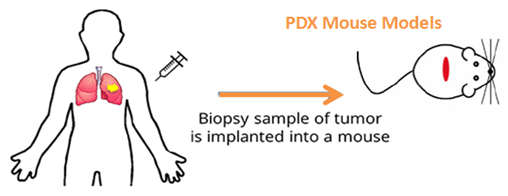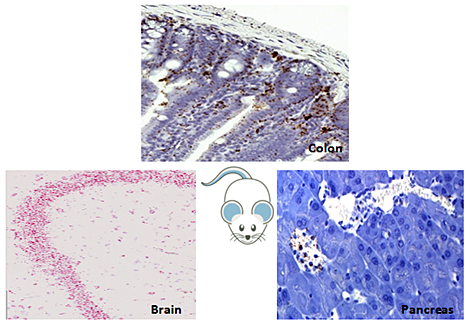- You are here: Home
- Services
- ISH/FISH Services
- FISH Applications
- Mouse Model and PDX Analysis (FISH)
Services
-
Cell Services
- Cell Line Authentication
- Cell Surface Marker Validation Service
-
Cell Line Testing and Assays
- Toxicology Assay
- Drug-Resistant Cell Models
- Cell Viability Assays
- Cell Proliferation Assays
- Cell Migration Assays
- Soft Agar Colony Formation Assay Service
- SRB Assay
- Cell Apoptosis Assays
- Cell Cycle Assays
- Cell Angiogenesis Assays
- DNA/RNA Extraction
- Custom Cell & Tissue Lysate Service
- Cellular Phosphorylation Assays
- Stability Testing
- Sterility Testing
- Endotoxin Detection and Removal
- Phagocytosis Assays
- Cell-Based Screening and Profiling Services
- 3D-Based Services
- Custom Cell Services
- Cell-based LNP Evaluation
-
Stem Cell Research
- iPSC Generation
- iPSC Characterization
-
iPSC Differentiation
- Neural Stem Cells Differentiation Service from iPSC
- Astrocyte Differentiation Service from iPSC
- Retinal Pigment Epithelium (RPE) Differentiation Service from iPSC
- Cardiomyocyte Differentiation Service from iPSC
- T Cell, NK Cell Differentiation Service from iPSC
- Hepatocyte Differentiation Service from iPSC
- Beta Cell Differentiation Service from iPSC
- Brain Organoid Differentiation Service from iPSC
- Cardiac Organoid Differentiation Service from iPSC
- Kidney Organoid Differentiation Service from iPSC
- GABAnergic Neuron Differentiation Service from iPSC
- Undifferentiated iPSC Detection
- iPSC Gene Editing
- iPSC Expanding Service
- MSC Services
- Stem Cell Assay Development and Screening
- Cell Immortalization
-
ISH/FISH Services
- In Situ Hybridization (ISH) & RNAscope Service
- Fluorescent In Situ Hybridization
- FISH Probe Design, Synthesis and Testing Service
-
FISH Applications
- Multicolor FISH (M-FISH) Analysis
- Chromosome Analysis of ES and iPS Cells
- RNA FISH in Plant Service
- Mouse Model and PDX Analysis (FISH)
- Cell Transplantation Analysis (FISH)
- In Situ Detection of CAR-T Cells & Oncolytic Viruses
- CAR-T/CAR-NK Target Assessment Service (ISH)
- ImmunoFISH Analysis (FISH+IHC)
- Splice Variant Analysis (FISH)
- Telomere Length Analysis (Q-FISH)
- Telomere Length Analysis (qPCR assay)
- FISH Analysis of Microorganisms
- Neoplasms FISH Analysis
- CARD-FISH for Environmental Microorganisms (FISH)
- FISH Quality Control Services
- QuantiGene Plex Assay
- Circulating Tumor Cell (CTC) FISH
- mtRNA Analysis (FISH)
- In Situ Detection of Chemokines/Cytokines
- In Situ Detection of Virus
- Transgene Mapping (FISH)
- Transgene Mapping (Locus Amplification & Sequencing)
- Stable Cell Line Genetic Stability Testing
- Genetic Stability Testing (Locus Amplification & Sequencing + ddPCR)
- Clonality Analysis Service (FISH)
- Karyotyping (G-banded) Service
- Animal Chromosome Analysis (G-banded) Service
- I-FISH Service
- AAV Biodistribution Analysis (RNA ISH)
- Molecular Karyotyping (aCGH)
- Droplet Digital PCR (ddPCR) Service
- Digital ISH Image Quantification and Statistical Analysis
- SCE (Sister Chromatid Exchange) Analysis
- Biosample Services
- Histology Services
- Exosome Research Services
- In Vitro DMPK Services
-
In Vivo DMPK Services
- Pharmacokinetic and Toxicokinetic
- PK/PD Biomarker Analysis
- Bioavailability and Bioequivalence
- Bioanalytical Package
- Metabolite Profiling and Identification
- In Vivo Toxicity Study
- Mass Balance, Excretion and Expired Air Collection
- Administration Routes and Biofluid Sampling
- Quantitative Tissue Distribution
- Target Tissue Exposure
- In Vivo Blood-Brain-Barrier Assay
- Drug Toxicity Services
Mouse Model and PDX Analysis (FISH)
Over the past century, the mouse has become a key mammalian model system for genetic research due to it genetic and physiological similarities to human. And Patient-derived xenografts (PDX) are increasingly used in cancer research as a tool to inform cancer biology and drug response, which is allow for accurate and reproducible target discovery. All these models need to be molecular analyses.

Fluorescent In situ hybridization (FISH) is a great tool can be applied to differentiate between murine (host) cells and human (grafted) cells and as methods to detect mouse gene expression with morphological context in a multitude of mouse models. With years of professional experience in the FISH Probe and FISH Service field, Creative Bioarray’s streamlined process can offer timely and dependable Mouse Model and PDX Analysis (FISH) results, give you the flexibility to focus on other research priorities.
Applications
- KO/KD/KI Mouse Models
FISH can be used to confirm the targeted gene deletion or conditional knockout (KO), knockdown (KD), or knock-in mouse
- Disease Models
Mouse models of human disease, including cardivascular disease, diabetes and obesity, colities and rare genetic diesase. FISH can be used to identify genes involved in the disease.
- Patient-derived Xenograft (PDX) Models
Humanized and patient-derived xenograft (PDX) mouse that require characterization of species-specific cell types. FISH can be used to differentiate between murine (host) cells and human (grafted) cells.
 Figure 1. Gene expression analysis for any biomarkers in any tissues in mouse models
Figure 1. Gene expression analysis for any biomarkers in any tissues in mouse models
 Figure 2. Human- and Mouse-Specific RNA Detection in Patient-Derived Xenografts (PDX)
Figure 2. Human- and Mouse-Specific RNA Detection in Patient-Derived Xenografts (PDX)
Features
- Accurate - In situ Detection Service-Custom design your probe
- Value - We focus on the quality of our service and all surpported by competitive pricing
- Efficiency - We are able to provide the fastest turnaround time of any supplier in the industry
Quotation and ordering
Our customer service representatives are available 24hr a day! We thank you for choosing Creative Bioarray at your preferred Mouse Model and PDX Analysis (FISH) Services.
References
- Han K D.; et al. Application of fluorescent in situ hybridization in the mouse xenograft model of human fat grafting[J]. Aesthetic surgery journal, 2012, 32(6): 745-750.
- Liu J F.; et al. Establishment of patient-derived tumor xenograft models of epithelial ovarian cancer for preclinical evaluation of novel therapeutics[J]. Clinical Cancer Research, 2017, 23(5): 1263-1273.
- Yu J.; et al. Establishing and characterizing patient-derived xenografts using pre-chemotherapy percutaneous biopsy and post-chemotherapy surgical samples from a prospective neoadjuvant breast cancer study[J]. Breast Cancer Research, 2017, 19(1): 130.
- Héroult M.; et al. Anti-tumor efficacy of the selective pan-FGFR Inhibitor BAY 1163877 in preclinical squamous cell carcinoma models of different origin[J]. Cancer Res, 2015, 75.
- Facompre N D.; et al. Barriers to generating PDX models of HPV‐related head and neck cancer[J]. The Laryngoscope, 2017, 127(12): 2777-2783.
Explore Other Options
For research use only. Not for any other purpose.

